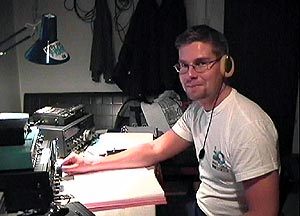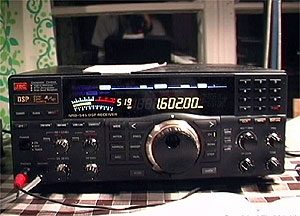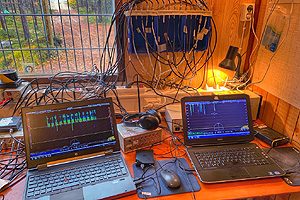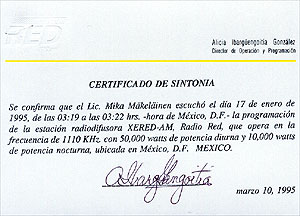|
Introduction to DXing
by Mika
Mäkeläinen
DXing means listening to
far-away — usually foreign — radio
stations. Listening to your regular hometown station
is not DXing, but listening to a similar station
thousands of kilometers away, outside the normal
coverage area, is DXing.
The term DX is most often
explained like this: "D" is said to mean
distance, and "X" refers to the unknown.
While this etymology is appealing and fitting, the
origin of DX is simple: DX means distance,
just as RX in radio parlance means a receiver —
and not an unknown receiver. DXers — hobbyists
who enjoy DXing — try to pick up radio stations,
which normally would not be audible at such a distance.
Most DXers concentrate on finding rare and distant
broadcasting
stations. This refers to radio stations that are
meant to be listened to by the general public. Radio
waves are also used by various utility
stations from cellphone companies to sea and air
traffic as well as the military and other authorities,
and some DXers enjoy hunting these signals as well.

Compare the mediumwave
(MW/AM) band in daytime and in nighttime, and
you will hear how the band if full of distant
signals at night. |
DXing was the way to learn
about the world and connect with the outside world
in real time before satellite television and the
Internet. Even today, DXing offers an intriguing
and challenging way to get in touch with remote
corners of the world.
DXers should not
be confused with radio amateurs — also known
as ham operators. Unlike a ham operator, a DXer
doesn't transmit anything himself and doesn't therefore
need any license. DXers
don't need to know about electronics, radio technology,
or morse code, but as a hobby DXing can be equally
challenging.
The challenge lies in picking up radio signals at
an incredible distance. In other parts of the world
there are still hundreds of radio stations, which
no one on your continent has ever heard, but which
could be picked up at your location under ideal
conditions — by an experienced DXer, who knows
what, where and when to hunt.
DXing broadcasting stations
is a legal hobby all around the world, with the
exception of North Korea.
Night
time is the right time
If you only listen
to FM stations,
you know that the same stations can be heard day
after day. The FM radio signal radiates directly
from the transmitter antenna to all directions.
Because the earth is round, and the FM signal doesn't
bend, FM radio stations are normally not heard much
beyond the horizon. Under exceptional circumstances
even an FM signal can bounce back from the atmosphere,
and these kind of special reception conditions are
what FM DXers are after.
However, most DXers are
interested in AM
(mediumwave) and shortwave
stations. If you have listened to the AM band, you
know that more stations can be heard during the
night than during the day. This is because at night
a certain layer in the ionosphere
(which is part of the atmosphere) reflects signals
back to the earth.

In the 1990's this is
what a DXer's communications receiver looked
like. A beginner can start with any receiver
which has shortwave bands (all or parts of the
frequency range 3-30 MHz) and a digital frequency
display. |
Sunlight however creates a
new different kind of layer at a lower altitude that
weakens radio signals, especially on the AM band,
so that you can no longer hear stations from far away.
Therefore long distance AM reception is usually possible
only when both the transmitter and the receiver —
and the path
in between — fall under darkness.
Radio propagation on most shortwave frequencies
is rather similar. Therefore, around sunset, DXers
are eagerly trying to hunt for signals coming from
the east. Likewise, sunrise is the best time to hear
stations from the west. At these times, interfering
stations from other directions are not quite as strong
as for example around midnight, when stations from
all possible directions are heard and when they can
cause interference to each other. Reception conditions
change constantly due to a variety of factors, some
of which are unpredictable. Therefore, scoring rare
catches requires constant monitoring of the stations
audible.
Send
a reception report...
DXers use special
equipment to monitor the airwaves. The cheapest
option is a so-called world band receiver, which
is a portable receiver with shortwave bands. A step
up are communications receivers, which are specifically
designed for semi-professional listeners. The best
such receivers are very sophisticated, but can be
bulky and expensive.
After the year 2000
the first software-defined receivers (SDR) came
on the market. These are often small in size, are
very good value for the money, and rely on a computer
for processing power. The biggest benefit of an
SDR is that it can often record a very wide frequency
range, for instance the entire mediumwave band,
simultaneously. An SDR works like a time machine,
allowing a DXer to capture an exceptional moment
not just on one single frequency, but over 100 frequencies
at the same time. Decent SDRs can be found from
around 150-200 euros/dollars upward.

Since around 2005-2010
most DXers have used so-called SDRs, software
defined receivers, which are connected to a
PC. In this photo an SDR receiver called Perseus
is the small black box on the right. Click to
enlarge. This setup is from Aihkiniemi,
a famous DX shack in Finland. |
An expensive receiver
is however useless without a good antenna. Most
DXers use antennas made of copper wire, which is
hung on trees or poles outside. In the extreme end
these antennas can be over 1 kilometer in length.
If an outdoor antenna is not an option, a small
"active antenna" can be used also indoors.
You can get started in the hobby using simple and
inexpensive equipment, but you can easily spend
enormous amounts of time and money to improve your
hardware.
After hearing an
interesting station, DXers try to identify the station
in question. This is often difficult because of
poor reception quality. The station may also be
transmitting in a language that the DXer doesn't
understand. Over the years DXers develop elementary
skills in a wide range of languages and at least
learn to recognize different languages, styles of
music and identification patterns. Handbooks (especially
World Radio TV Handbook), DXers' magazines and websites
like DXing.info help in planning what frequencies
and when to listen to, and also help in analyzing
your catches.
For future reference, all interesting signals are
recorded. By reviewing notes and recordings made
at the time of listening, many DXers compile reception
reports, which they send to the station.
Nowadays this is done mostly by email or via social
media. A reception report includes all the details
of what, where, when, and how the station was heard
by the distant listener. A recorded audio clip of
a station identification should be enclosed as proof
of having heard the station. In the report, DXers
request a confirmation in return — this can
be in the form of an email, a simple reply on social
media, or a more traditional QSL
card or letter by mail from the station verifying
that the signal was indeed theirs.
In the past reception reports used to be valuable
feedback for international broadcasters, but nowadays
when monitoring reception quality is in many causes
automated and more professional, many stations find
themselves inundated with reception reports that
are not much use, and reply just out of courtesy.
Domestic broadcast stations can however be positively
surprised that their small local station has been
picked up in a distant country, even though far-away
listeners are not part of their target audience.
...
and hope for a reply

Traditionally QSLs have
been in the form of cards like the above from
the Mexican station XERED (1110 kHz), but nowadays
emails and messages on social media are more
common. |
DXers collect
these verifications — known as QSLs —
as mementos of their discoveries on the dial,
and also to demonstrate how many stations they
have been able to pick up. Even though QSLs can't
be considered as definite evidence of hearing
a station — as some stations routinely confirm
even insufficient reports and other stations hardly
ever reply to any reports — collecting QSLs
remains a major pursuit for many DXers. Competitions
between DXers are usually based on the number
of QSLs received. Increasingly, also recordings
of station identifications are collected, counted
and saved as evidence of hearing remote stations.
On DXing.info you can get a taste of many
different aspects of DXing; read inside accounts
on hunting elusive rarities on DX-expeditions
(DXpeditions), listen to audio
samples of distant radio stations, and browse
articles
on DXing or profiles
of radio stations. Enjoy the site — but don't
forget to switch your radio on, and discover for
yourself what surprising signals the airwaves
may bring your way tonight!
(updated in January
2021)
 
|